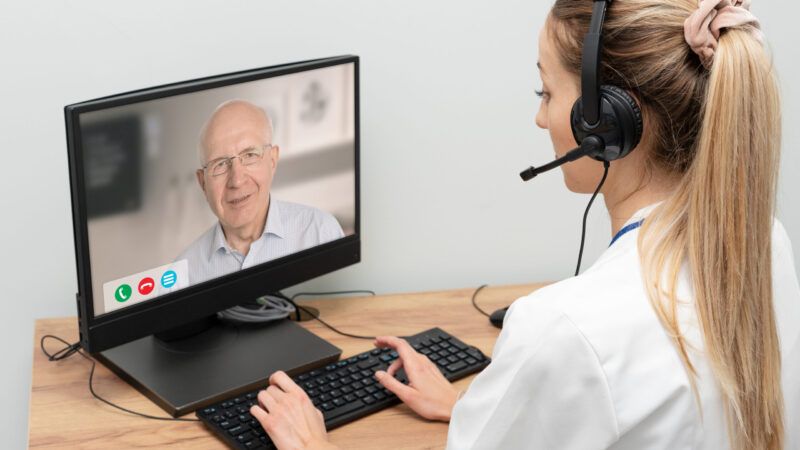We Should Keep Expanding Telehealth, Even After the Pandemic
Senators and state officials are proposing ways to sweep aside nonsensical regulations that place geographic limits on telehealth.

At the outset of the COVID-19 pandemic, many states waived existing restrictions on telehealth so doctors and patients could continue to consult without having face-to-face visits.
Now, with the end of the pandemic hopefully within sight, some state and federal lawmakers are looking to keep those arbitrary and nonsensical restrictions from coming back into force.
Sens. Brian Schatz (D–Hawaii) and Tim Scott (R–S.C.) on Tuesday introduced a bill to abolish some particularly silly Medicare restrictions on telehealth that effectively prevent many older Americans from taking advantage of the option to consult with a doctor from the comfort of home. Under Medicare's existing "geographic and originating site" rules, patients can only use telehealth services if they live in an area defined as having a shortage of health professionals by the Department of Health and Human Services. Even sillier, the rule requires that Medicare patients can only use telehealth services from an existing medical clinic or doctor's office—which means you have to leave home and drive to a doctor's office in order to use a webcam to chat with a doctor in a different office.
As a result, most of America's 61 million Medicare recipients—many of whom are elderly and may have difficulty leaving home—are completely cut-off from one of the best ways that modern technology helps deliver vital services. It's not the 1980s anymore, but Medicare forces senior citizens to get medical treatment as if it were.
Those restrictions were lifted on a temporary basis due to COVID-19, but Schatz and Scott are right to want them gone for good. In announcing their bill, the Telehealth Modernization Act, the two senators noted that about 40 percent of all Medicare visits between April and July of last year took place remotely.
"Telehealth has been a godsend for millions of Americans receiving health care services during the pandemic, while ensuring the spread of the virus stays at a minimum," Scott said in a statement. "Updating our laws to solve today's challenges through commonsense and practical approaches will ensure more access to health care and a safer aging population."
While those changes to Medicare's rules would be a big development at the federal level, there are also many state-level obstacles to a more robust telehealth system that should be left on the sidelines when the pandemic ends. One of the biggest issues is the lines between the states—and, more specifically, the licensing regulations that often prohibit doctors in one state from seeing virtual patients who live somewhere else.
"A person can travel from, say, Phoenix, Arizona, to Los Angeles, California, to consult and receive care from a renowned expert in a unique medical condition, but cannot do telehealth follow up appointments with that practitioner unless that practitioner gets a license in Arizona," writes Jeffrey Singer, an Arizona-based physician and senior fellow at the Cato Institute. (Disclosure: Singer is a financial supporter of Reason Foundation, the nonprofit that publishes this website.) "In other words, the patient can travel to the doctor, but the doctor cannot travel to the patient."
Changing Medicare's rules so an out-of-state doctor can get paid for telehealth services won't actually open up the market unless states change their licensing rules to allow those virtual visits to take place.
Thankfully, some states are taking the initiative to remove such barriers. Lawmakers in Arizona have introduced the most ambitious proposal, says Courtney Joslin, a resident fellow at the R Street Institute, a free market think tank. The bill would require insurers to cover telehealth visits at the same rates as in-person visits and would permit Arizonans to get telehealth services from doctors in other states.
The Arizona bill aims to "create a permanent, stable, and innovative telehealth market for Arizonans" and is a model for other states to follow, says Joslin. "The demand for telehealth services erupted almost overnight once state lockdowns set in last year, and has become immensely popular. Why should legislators move slowly in allowing it to stick around?"
Indeed, it's a shame that it took a global pandemic to spur lawmakers to make some of these common-sense changes at the state and federal levels. Telehealth is no longer a fringe service that should be seen as a last-ditch effort to bring medical access to areas with shortages—it's a mainstream aspect of a modern health care system that should stick around even after COVID-19 is gone.
Show Comments (11)